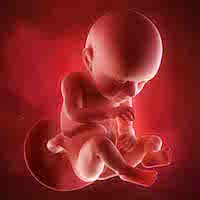37 Weeks Pregnant
37 weeks used to be considered a full-term pregnancy, but doctors now consider 39 weeks full-term. Still, you’re getting very close to holding your baby in your arms. At this point in your pregnancy, you may be more than ready to get this show on the road and have your baby, or you may be a little apprehensive about what’s to come. Either way, enjoy your downtime while you can. Try to relax these last few weeks before your baby arrives.
What’s happening with your body?
 Now that you’re getting close to having your baby, you might not notice a lot of changes from week to week. Your baby’s weight gain is slowing down and yours may too. In fact, many women don’t gain any weight in their last month.
Now that you’re getting close to having your baby, you might not notice a lot of changes from week to week. Your baby’s weight gain is slowing down and yours may too. In fact, many women don’t gain any weight in their last month.
At week 37, your body is preparing for labor and lactation. If your breasts have not started to leak colostrum, they may in the next few weeks. You might also notice an increase in vaginal discharge.
Your baby may have already dropped into your pelvis in preparation for birth. If not, it should happen shortly. When your baby drops, you might notice less pressure on your digestive organs and it may be easier to breath. But the tradeoff is you may have increased pelvic and bladder pressure.
Usually during your last month of pregnancy, your healthcare provider will recommend more frequent visits. At this point, your doctor may schedule weekly appointments to monitor your baby and determine if you are getting close to delivering.
Your doctor will check your cervix to determine effacement and dilation. Effacement is the changes in your cervix including thinning and softening in preparation for labor. Your doctor will measure effacement in percentages. Dilation is the opening of your cervix. Both dilation and effacement can start weeks before labor.
What’s happening with your baby?
 Although your baby is still considered early full-term, you’re close enough to your due that it is considered safe to go into labor. At 37 weeks, your baby may weigh about six and a half pounds. She is still gaining weight, but at a slower pace and may put on about half a pound to a pound before birth.
Although your baby is still considered early full-term, you’re close enough to your due that it is considered safe to go into labor. At 37 weeks, your baby may weigh about six and a half pounds. She is still gaining weight, but at a slower pace and may put on about half a pound to a pound before birth.
Her lungs are likely producing surfactant and ready to take their first breath. But if your baby spends a few more weeks inside, it helps her brain and other organs become a bit more mature.
Baby’s dexterity is also improving. He can grasp things better. For instance, he is sucking more frequently as it provides comfort and also gets him ready for feeding. He is probably in the head down position ready to make the trip out into the world.
Thing to keep in mind:
By 37 weeks, labor is right around the corner. If you have been getting Braxton Hicks contractions, you might wonder how you’ll be able to tell the difference between real labor and false labor. You don’t want to run to the hospital frequently only to be turned away and told you’re not in labor. But you don’t want to wait too long and unintentionally deliver your baby in your living room.
So how can you tell if what you’re feeling is false labor or the real thing? If it’s the real deal, labor will progress. But at first, it can be difficult to distinguish between Braxton Hicks contractions and real labor, especially since Braxton Hicks contractions may get stronger as you get closer to your due date. But there are a few factors that indicate, labor has started.
If you are experiencing real labor contractions, they become more intense as time goes on. They also start coming more frequently. Braxton Hicks contractions tend to be irregular, and the intensity may stay the same.
Braxton Hicks contractions may let up if you change positions. Real contractions tend to be the same even if you stand up, walk or move. True labor may be felt in your back and abdomen. Braxton Hicks contractions are usually not felt in your back.
The bottom line is, if a pattern is starting to develop and contractions are coming at regular intervals and getting strong, it is probably the real thing. But if you’re in doubt, your best bet is to get checked out.